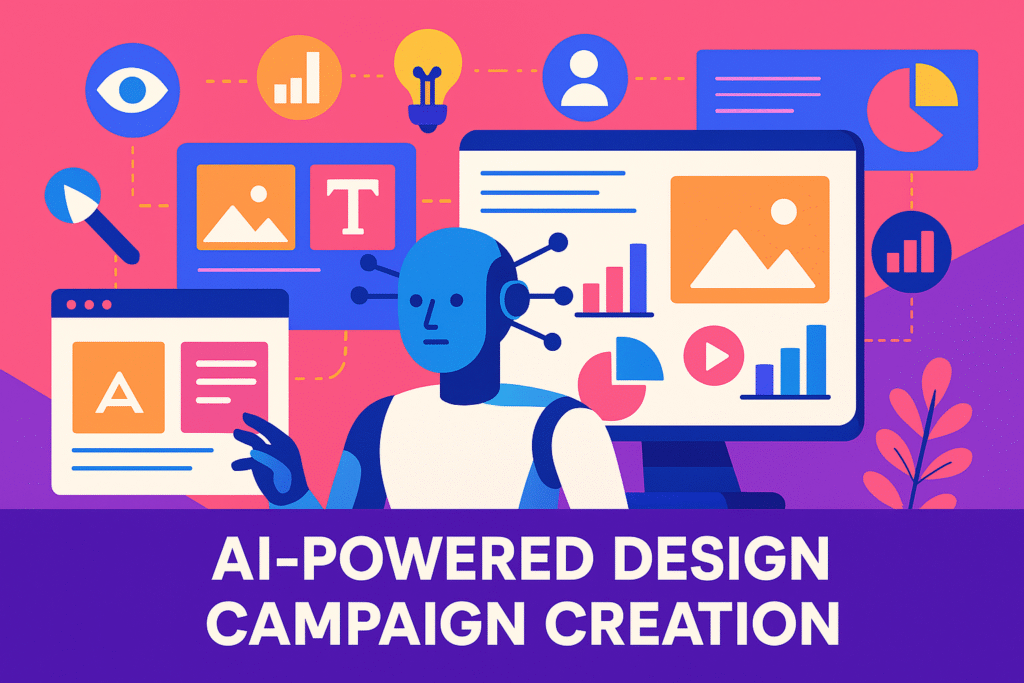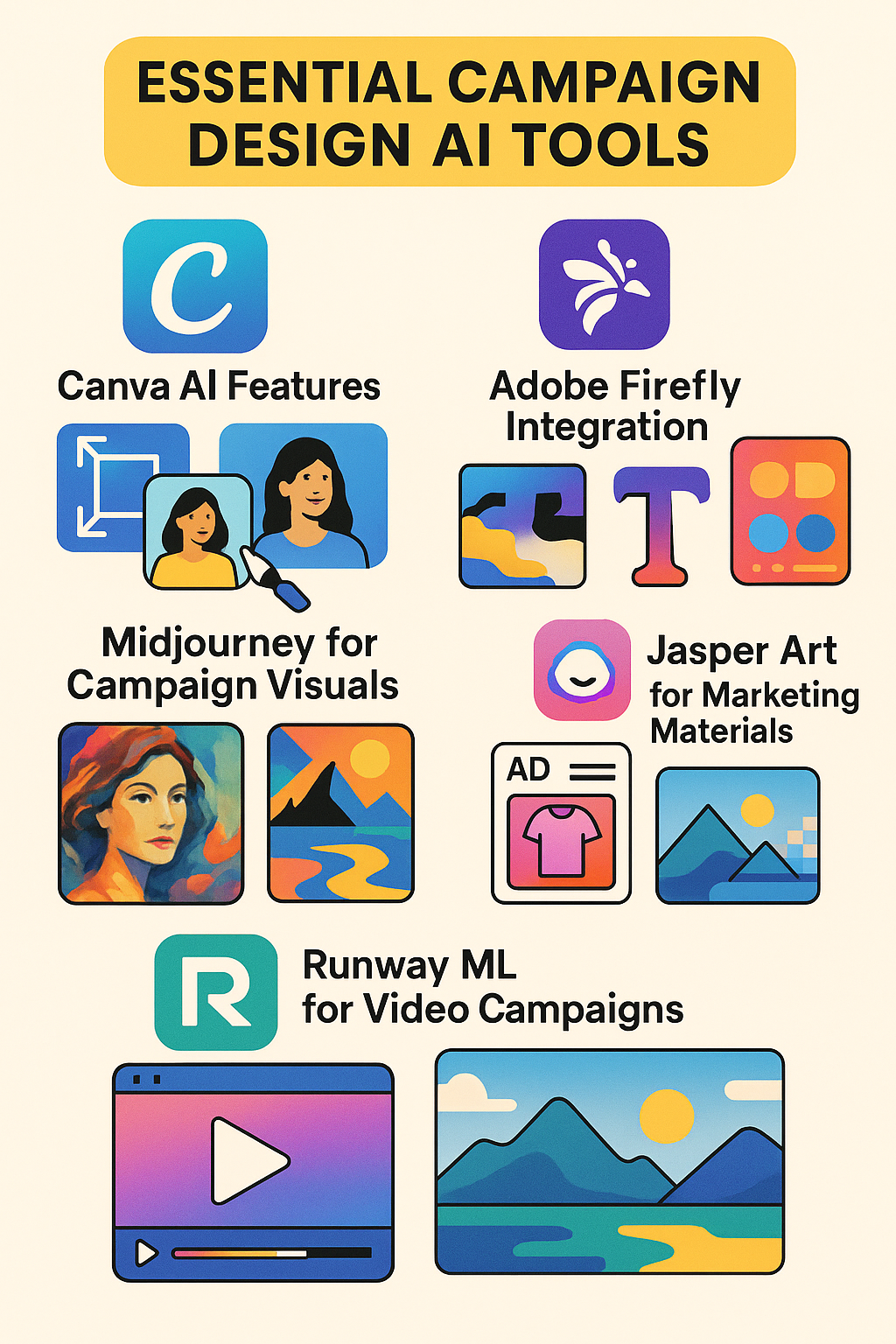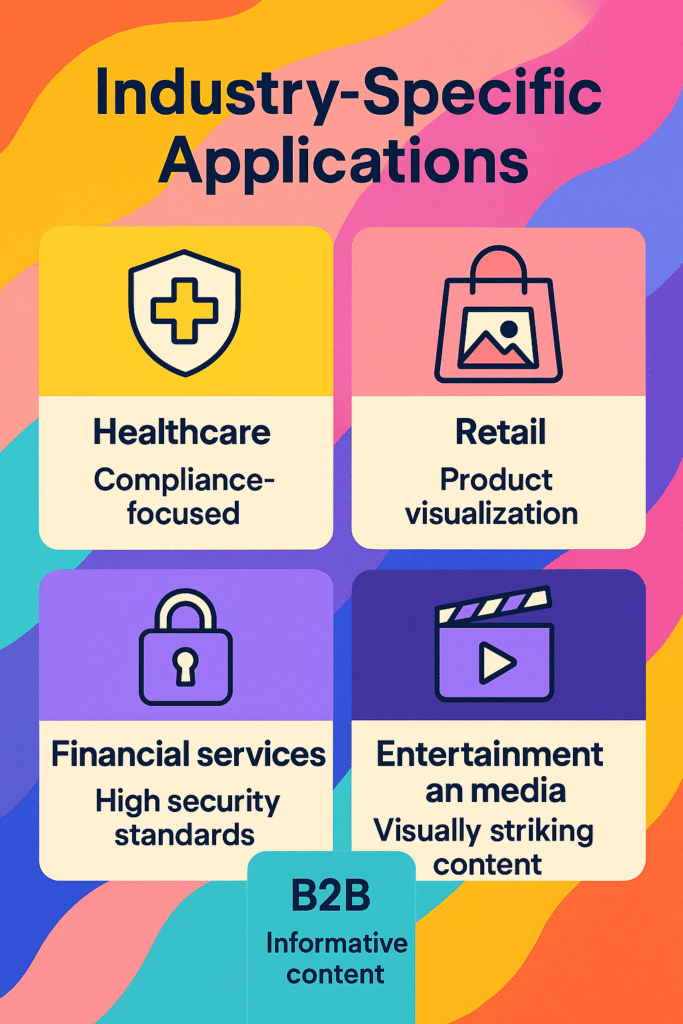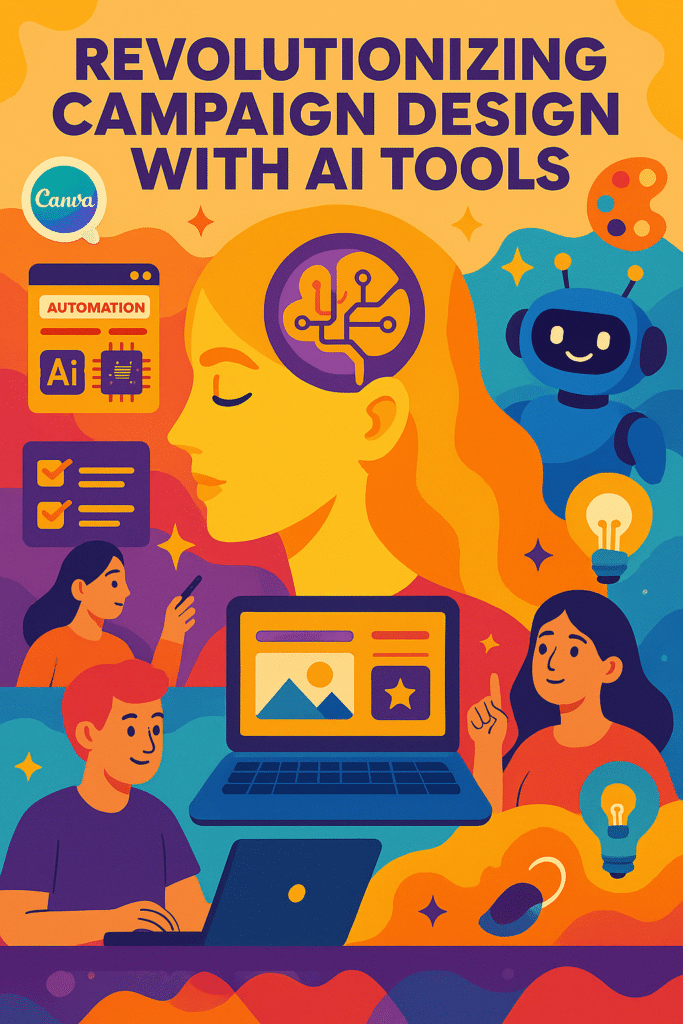Table of Contents
Campaign design AI tools have completely reshaped how marketers approach creative development. Modern businesses struggle with tight deadlines, limited budgets, and the constant pressure to produce engaging content that stands out in crowded digital spaces. Traditional design methods often fall short when teams need to create multiple variations, test different concepts, or scale campaigns across various platforms.
The marketing landscape demands speed without sacrificing quality. Teams spend countless hours on repetitive tasks like resizing images, creating variations, and maintaining brand consistency across channels. This is where artificial intelligence steps in to solve these persistent challenges.

The Role of AI in Campaign Design
Artificial intelligence has become the backbone of modern campaign creation. These tools analyze vast amounts of data to understand design patterns, color psychology, and consumer preferences. Machine learning algorithms can predict which design elements will perform better based on historical data and current trends.
AI-powered platforms now handle everything from initial concept generation to final asset production. They can create multiple design variations in minutes, test different approaches simultaneously, and optimize campaigns based on real-time performance data. This automation allows creative teams to focus on strategy and innovation rather than manual execution.
The technology also enables personalization at scale. AI can generate customized content for different audience segments, adjusting messaging, visuals, and formats based on demographic data and behavioral patterns. This level of personalization was previously impossible with traditional design workflows.
Benefits of Using AI in Campaign Design
Speed and Efficiency
Campaign design AI tools reduce production time by up to 80% compared to traditional methods. Teams can generate dozens of design variations in the time it previously took to create a single concept. This acceleration is particularly valuable for time-sensitive campaigns or when testing multiple approaches.
Automated workflows eliminate bottlenecks in the creative process. Designers no longer need to manually resize images for different platforms or create variations for A/B testing. The AI handles these repetitive tasks while maintaining quality standards.
Cost Reduction
Organizations save significant resources by reducing the need for large design teams or expensive external agencies. A single designer equipped with AI tools can produce the same output as an entire traditional creative department. This democratization of design capabilities allows smaller businesses to compete with larger enterprises.
The technology also reduces iteration costs. Making changes to campaigns becomes instant rather than requiring new rounds of design work. Teams can test multiple concepts without additional design fees or time delays.
Enhanced Creativity
Contrary to concerns about AI replacing human creativity, these tools actually enhance creative potential. They provide inspiration by suggesting design elements, color combinations, and layouts that designers might not have considered. The AI acts as a creative partner, offering suggestions while leaving final decisions to human judgment.
Advanced platforms can generate entirely new concepts based on brief descriptions or reference materials. This capability helps overcome creative blocks and provides fresh perspectives on familiar challenges.
Essential Campaign Design AI Tool

Canva AI Features
Canva has integrated several AI capabilities that streamline campaign creation. The Magic Resize feature automatically adapts designs for different platforms, maintaining visual consistency while optimizing for each channel’s requirements. This tool eliminates the tedious process of manually creating variations for social media, print, and web applications.
The platform’s Background Remover uses AI to isolate subjects from images instantly. This feature saves hours of manual editing work and enables quick composition changes. Canva’s AI also suggests design elements based on the content type and industry, helping users create professional-looking campaigns without extensive design knowledge.
Text-to-image generation capabilities allow users to create custom visuals from simple descriptions. This feature is particularly useful for creating unique imagery that aligns with specific campaign themes or brand requirements.
Adobe Firefly Integration
Adobe has embedded AI throughout its Creative Cloud suite, with Firefly leading the charge in generative capabilities. The tool can create original images, graphics, and text effects from natural language descriptions. This integration allows designers to generate custom assets without leaving their familiar Adobe workspace.
Firefly’s content-aware fill feature can remove or replace objects in images while maintaining realistic backgrounds. This capability streamlines photo editing workflows and enables quick adaptations of existing visual assets for new campaigns.
The platform also offers AI-powered font pairing suggestions and color palette generation based on uploaded images or brand guidelines. These features help maintain consistency while exploring creative possibilities.
Midjourney for Campaign Visuals
Midjourney excels at creating artistic and conceptual visuals that capture attention in crowded marketing environments. The platform generates unique imagery that would be difficult or expensive to produce through traditional photography or illustration.
The tool’s style consistency features allow marketers to maintain visual coherence across campaign assets. Users can reference specific styles or aesthetics and apply them to multiple image generations, ensuring brand alignment throughout the campaign.
Midjourney’s ability to blend concepts and styles makes it particularly valuable for creating metaphorical or abstract visuals that convey complex brand messages. The platform has become essential for campaigns requiring distinctive artistic elements.
Jasper Art for Marketing Materials
Jasper Art specializes in creating marketing-focused visuals that align with copywriting and content strategy. The platform integrates with Jasper’s writing tools, enabling seamless coordination between visual and written content.
The tool offers templates and styles specifically designed for marketing applications, including social media posts, advertisements, and promotional materials. This focus on marketing use cases results in more commercially viable outputs compared to general-purpose AI art generators.
Jasper Art also provides brand customization options, allowing teams to train the AI on specific brand guidelines and visual preferences. This feature ensures consistency across all generated materials while maintaining the unique brand identity.
Runway ML for Video Campaigns
Video content dominates modern marketing, and Runway ML provides powerful AI tools for video campaign creation. The platform offers text-to-video generation, allowing marketers to create animated content from written descriptions.
Advanced editing features include AI-powered scene transitions, automatic subtitle generation, and background replacement. These capabilities enable small teams to produce professional-quality video content without extensive technical expertise or expensive equipment.
The platform’s real-time collaboration features support distributed teams working on video campaigns. Multiple users can contribute to projects simultaneously, with AI handling complex rendering and processing tasks in the background.
Automation in Campaign Design Workflows
Modern campaign design workflows leverage automation to handle routine tasks and optimize creative processes. AI tools can automatically generate multiple design variations, test different approaches, and select the best-performing options based on predefined criteria.
Automated asset generation reduces the time between concept and execution. Teams can input campaign parameters, and the AI creates complete asset libraries including images, graphics, and text variations. This automation is particularly valuable for large-scale campaigns requiring hundreds of individual assets.
The technology also enables automated quality control, checking designs against brand guidelines and flagging potential issues before publication. This feature prevents costly mistakes and ensures consistency across all campaign materials.
Brand consistency becomes easier to maintain when AI tools handle asset creation. The systems can apply brand guidelines automatically, ensuring color schemes, fonts, and visual styles remain consistent across all generated content.
Collaboration Features in AI Design Platforms
Modern AI design platforms emphasize collaboration, enabling teams to work together seamlessly regardless of location. Cloud-based systems allow multiple users to contribute to projects simultaneously, with AI handling version control and conflict resolution.
Real-time feedback systems enable stakeholders to review and approve designs without lengthy email chains or meeting cycles. AI can incorporate feedback automatically, making suggested changes and presenting updated versions for review.
The platforms also provide detailed project histories, allowing teams to track changes and revert to previous versions when needed. This transparency improves communication and reduces conflicts during the creative process.
Team management features help organize workflows and assign responsibilities. AI can suggest optimal team compositions based on project requirements and individual skills, improving overall efficiency and output quality.
Campaign Management Through AI Integration
AI integration extends beyond design creation to encompass entire campaign management workflows. These systems can track campaign performance, suggest optimizations, and automatically adjust creative elements based on real-time data.
Performance analytics provide insights into which design elements resonate with different audience segments. AI can identify patterns in successful campaigns and apply these learnings to future projects, continuously improving results over time.
The technology also enables predictive campaign management, forecasting potential issues before they occur. This capability allows teams to proactively address challenges and maintain campaign effectiveness throughout the execution period.
Resource allocation becomes more efficient when AI handles routine campaign management tasks. Teams can focus on strategy and creative development while the AI manages technical implementation and optimization.
Advanced AI Features for Campaign Optimization
Machine learning algorithms continuously analyze campaign performance to identify optimization opportunities. These systems can suggest design modifications, timing adjustments, and targeting refinements based on real-time data analysis.
Dynamic content generation allows campaigns to adapt automatically to changing conditions. AI can modify messaging, visuals, and calls-to-action based on audience behavior, seasonal trends, or competitive activities.
Predictive modeling helps teams anticipate campaign performance before launch. These tools analyze historical data and market conditions to forecast results and suggest improvements during the planning phase.
A/B testing becomes more sophisticated with AI management. The systems can test multiple variables simultaneously, identify winning combinations faster, and implement optimizations automatically without human intervention.
Integration with Marketing Technology Stack
Modern campaign design AI tools integrate seamlessly with existing marketing technology platforms. These connections enable automated workflows that span from initial design creation through campaign execution and performance analysis.
CRM integration allows AI tools to access customer data and create personalized campaign assets. This capability enables mass customization at scale, with each customer receiving tailored content based on their preferences and behavior history.
Social media management platforms can automatically publish AI-generated content across multiple channels, optimizing posting schedules and content formats for each platform’s unique requirements.
Email marketing integration enables the creation of dynamic email campaigns with AI-generated visuals and copy that adapt based on recipient characteristics and engagement patterns.
Measuring Success with AI-Powered Analytics
AI-powered campaign success analytics provide detailed insights into campaign performance at both macro and micro levels. These systems track engagement metrics, conversion rates, and brand sentiment across all campaign touchpoints.
Attribution modeling becomes more accurate with AI analysis of customer journeys. The technology can identify which design elements contribute most to conversions and optimize future campaigns accordingly.
Predictive analytics help teams understand long-term campaign impact beyond immediate metrics. These insights enable more strategic decision-making and better resource allocation for future campaigns.
Real-time reporting dashboards provide instant visibility into campaign performance, allowing teams to make adjustments quickly when metrics indicate suboptimal results.
Best Practices for Implementation
Successful implementation of campaign design AI tools requires careful planning and gradual adoption. Teams should start with simple automation tasks before moving to more complex AI-driven processes.
Training and change management are crucial for successful adoption. Team members need to understand how to work effectively with AI tools while maintaining creative control over final outputs.
Quality control processes should be established to ensure AI-generated content meets brand standards and campaign objectives. Human oversight remains essential for maintaining quality and brand consistency.
Regular evaluation and optimization of AI workflows help teams maximize the benefits of these tools while avoiding common pitfalls and inefficiencies.
Overcoming Common Challenges
Technical integration challenges often arise when implementing AI tools within existing workflows. Teams should work closely with IT departments to ensure smooth integration and adequate system resources.
Creative concerns about AI replacing human creativity can be addressed through proper training and clear role definitions. AI should be positioned as a tool that enhances human creativity rather than replacing it.
Budget considerations require careful evaluation of tool costs versus potential savings and efficiency gains. Organizations should calculate total cost of ownership including training, integration, and ongoing subscription fees.
Data privacy and security requirements must be addressed when implementing AI tools that access customer information or proprietary design assets. Proper protocols and safeguards should be established before deployment.
Industry-Specific Applications

Different industries have unique requirements for campaign design AI tools. Healthcare organizations need compliance-focused features, while retail companies prioritize product visualization capabilities.
Financial services campaigns require high security standards and regulatory compliance features. AI tools serving this sector must include appropriate safeguards and audit trails.
Entertainment and media companies benefit from AI tools that excel at creating visually striking and emotionally engaging content. These organizations often require more advanced creative capabilities than traditional business applications.
B2B companies need AI tools that can create professional, informative content that builds trust and credibility with business audiences. The emphasis shifts from pure creativity to clear communication and value proposition presentation.
Cost-Benefit Analysis
Organizations implementing campaign design AI tools typically see return on investment within 3-6 months through reduced design costs and faster campaign development cycles.
Productivity gains often exceed 300% for routine design tasks, with teams able to produce significantly more content in the same timeframe. This efficiency improvement enables organizations to test more concepts and optimize campaigns more thoroughly.
Quality improvements result from AI’s ability to maintain consistency and apply best practices automatically. Campaigns show better performance when AI handles technical optimization while humans focus on creative strategy.
Long-term benefits include improved team satisfaction as designers focus on strategic and creative work rather than repetitive tasks. This shift often leads to better retention and more innovative campaign concepts.
Conclusion
Campaign design AI tools have fundamentally changed how marketing teams approach creative development. From Canva’s user-friendly automation to Midjourney’s artistic capabilities, these platforms offer unprecedented opportunities to create compelling campaigns efficiently and cost-effectively.
The key to success lies in understanding each tool’s strengths and integrating them effectively into existing workflows. Organizations that embrace these technologies while maintaining human creative oversight will gain significant competitive advantages in speed, cost, and campaign performance.
The future promises even more sophisticated AI capabilities, making now the ideal time to begin experimenting with these tools. Teams that develop AI expertise today will be better positioned to leverage more advanced features as they become available.
Start by identifying the most time-consuming aspects of current campaign design processes. Then select AI tools that address these specific pain points while fitting within existing budgets and workflows. With proper implementation and training, these tools can transform marketing operations and drive significantly better campaign results.
The transformation of campaign design through AI is not just about technology – it’s about reimagining how creative teams work, collaborate, and deliver value to their organizations. Embrace these tools as creative partners rather than replacements, and watch as they elevate both efficiency and creative output to new heights.
Frequently Asked Questions
What are the most important features to look for in campaign design AI tools?
Look for automation capabilities, brand consistency features, collaboration tools, and integration options with existing marketing technology. The tool should also provide good customer support and regular updates.
How do campaign design AI tools handle brand consistency?
Most platforms allow users to upload brand guidelines, color palettes, and style preferences. The AI then applies these consistently across all generated content, ensuring brand compliance without manual oversight.
Can small businesses benefit from campaign design AI tools?
Yes, these tools level the playing field by giving small teams access to enterprise-level design capabilities. Many platforms offer affordable pricing tiers specifically designed for smaller organizations.
What skills do team members need to use campaign design AI tools effectively?
Basic design knowledge is helpful but not essential. Most tools are designed for non-designers to use effectively. However, understanding marketing principles and brand strategy remains important for creating effective campaigns.
How do these tools integrate with existing marketing workflows?
Most AI design platforms offer APIs and integrations with popular marketing tools including CRM systems, social media management platforms, and email marketing software. This integration enables automated workflows across the entire marketing stack.
What are the limitations of current campaign design AI tools?
Current limitations include occasional inconsistencies in generated content, difficulty with complex brand guidelines, and the need for human oversight to ensure strategic alignment. However, these tools improve rapidly with regular updates.
